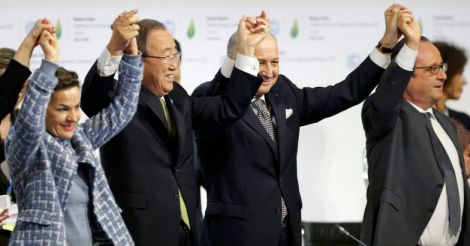The just-concluded climate agreement in Paris among 196 countries, even if ten years late, is highly significant—for three reasons.
For the first time, both developed countries such as the United States and the European Union and developing nations such as China and India signalled their conviction that we have a huge problem. Unless climate change is tackled head on, we are doomed. No longer can we pretend that climate change is someone else’s problem.
Second, the agreement calls for ending 100 years of fossil fuels (coal, oil and gas) that emit the most carbon. These emissions are the reason why the planet has been warming: 2015 is the warmest in 135 years of recorded history. Carbon cuts are to keep global temperatures from rising more than 2°C by 2100 and ideally below 1.5°C. Countries such as China and India that rely on fossil fuels for energy to the tune of 75% or more, have a huge task.
Third, the deal will encourage vast amounts of capital to be spent adapting to the effects of climate change—including infrastructure like sea walls and programs to deal with poor soil—and developing solar and wind power. There is a provision requiring developed countries to send $100 billion annually to their developing counterparts beginning in 2020. This has to be capitalised on.
That said, the Paris commitments are just the start of the transformation needed to save the planet. We just need to go much further in shifting to a low carbon path.
The agreement requires countries to report on progress towards meeting their climate commitments every five years and submit new plans to strengthen them. But it leaves it to the country to set its emissions targets and decide how it will meet them. The agreement will become international law once at least 55 countries comprising at least 55 percent of global emissions ratify it.
India’s proposal is to achieve 40% electric power installed capacity from non-fossil fuel resources by 2030, and reducing the emissions intensity of its GDP by 35% from 2005 levels. India has a huge lead on wind power and solar power, can promote the use of batteries and lead the world in the renewable energy revolution. With the cost renewable energy falling relative to fossil fuels, India has to be careful about the risk of fossil fuels becoming stranded assets.
India is the third largest emitter of carbon, while it has low emissions in per capita terms because of the large population. Also millions of people have no access to electricity, and finding low costs of providing access remains a priority. Technology transfer and climate finance to shift to low carbon technology are key for India.
India also has the most to gain from a better climate as it is one of the top most affected by climate-related calamities. With India’s long coastlines, low-lying regions and coastal zones of Gujarat, Kerala, Tamilnadu and Andhra Pradesh are vulnerable to more climate related cyclones and floods. Heatwaves claimed more than 3,000 lives this year, as well as livestock. This was coupled with a sharp drop in rainfall in areas covered by the southwest monsoon, which was 14 per cent weaker than last year. Some parts of India received less than half the expected rainfall.
For now, global temperatures will continue to rise and climate impacts will escalate over the coming decades because of the decades-long build-up of carbon in the air and the long lag in the climate system. Everywhere, better preparedness and adaptive measures against hazards of nature are more important than ever.


























Disclaimer
The comments posted here/below/in the given space are not on behalf of Manorama. The person posting the comment will be in sole ownership of its responsibility. According to the central government's IT rules, obscene or offensive statement made against a person, religion, community or nation is a punishable offense, and legal action would be taken against people who indulge in such activities.